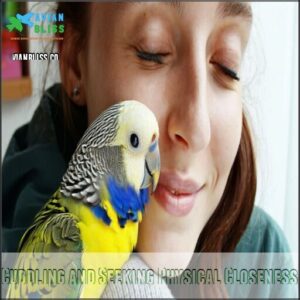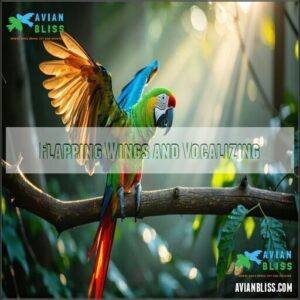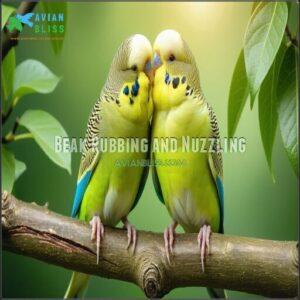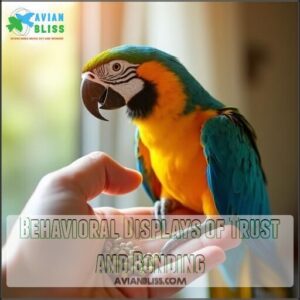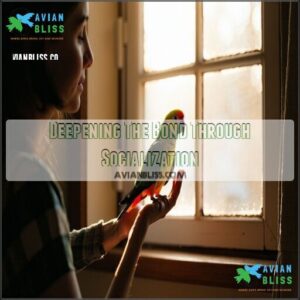This site is supported by our readers. We may earn a commission, at no cost to you, if you purchase through links.
 You’re looking for signs your bird trusts you.
You’re looking for signs your bird trusts you.
A trusting bird will show relaxed body language, seek your presence, and accept physical contact.
They’ll play and interact with you, and may even cuddle or nuzzle.
If you’re seeing these behaviors, it’s a good sign your bird feels comfortable around you.
But what does it mean when they start mimicking your voice or following you around the house?
There’s more to understanding your bird’s trust than just these initial signs, and exploring these behaviors can reveal a deeper connection.
They will also show that they trust you by wanting to be near you, which is a sign of trust.
Table Of Contents
- Key Takeaways
- Recognizing Trust in Body Language
- Physical Displays of Affection
- Signs of Trust in Social Behavior
- Vocal Displays of Trust and Communication
- Behavioral Displays of Trust and Bonding
- Creating a Comfortable Environment
- Building Trust and Strengthening The Bond
- Recognizing Signs of Affection
- Deepening The Bond Through Socialization
- Frequently Asked Questions (FAQs)
- How do I tell if my bird is bonded to me?
- How to tell if your bird is starting to trust you?
- How do you know if a bird is comfortable with you?
- How do you tell if your bird is happy to see you?
- How do you know when your bird trusts you?
- How do I know if my bird is bonded to me?
- How do you know if your bird is in love with you?
- How do you tell a bird I love you?
- How do you know if a bird is bonded to you?
- How can you tell if your bird is happy?
- Conclusion
Key Takeaways
- You’ll know your bird trusts you when they show relaxed body language, like a comfortable stance or soft feathers, and they’ll often seek your presence and accept physical contact.
- Your bird will play and interact with you, and may even cuddle or nuzzle, which are clear signs of trust and affection, so be sure to recognize and respond to these behaviors.
- Pay attention to your bird’s vocalizations, like happy chirps or whistling, and their behavior, such as preening or following you around, as these can indicate they feel safe and comfortable with you.
- To build trust with your bird, it’s essential to be patient, move slowly, and provide a comfortable environment, including a large enough cage, clean water, and a variety of toys, which will help your bird feel secure and deepen your bond.
Recognizing Trust in Body Language
You can tell if your bird trusts you by paying attention to its body language.
Birds show trust through relaxed body language and gentle interactions
By recognizing signs like relaxed posture and direct eye contact, you can better understand your bird’s behavior and strengthen your bond with it, which is crucial for building trust.
Relaxed Posture and Feather Position
You can tell a relaxed bird feels trust through its body language.
Look for:
- Relaxed feathers
- Comfortable stance
- Sleep posture
- Feather stretching.
A relaxed bird shows trust with slow movements and soft feathers.
Recognizing these signs helps you understand your bird’s trust and deepen your bond.
Tense Posture and Aggressive Behavior
Recognizing tense posture and aggressive behavior in your bird is essential.
Look for pinned eyes, sleek feathers, or hissing sounds, which signal anxiety or discomfort.
Fear biting and feather plucking may emerge when your bird feels overwhelmed.
Give them space and speak softly to avoid escalating bird aggression.
Avoiding contact and hissing sounds are clear "back off" warnings.
By addressing bird anxiety and understanding bird body language, you can rebuild bird trust and strengthen your bond, reducing aggressive reactions and preventing fear biting and feather plucking, which helps in minimizing fear biting.
Eye Contact and Gaze
You notice your bird’s eye contact is a sign of trust. A sustained gaze with soft eyes and a slow blinking rate indicates comfort.
Look for pupil dilation when excited or affectionate. Avoiding gaze when nervous but warming up over time is also a sign.
- Mutual gaze feels calm
- Pupil dilation shows excitement
- Slow blinking indicates ease
- Soft eyes convey trust
- Blinking rate slows down
Beak and Feather Positions
You observe bird trust signs through beak and feather positions.
Beak grinding and feather fluffing indicate relaxation.
A relaxed crest and tucked beak show comfort.
Pin feathers may also be visible.
These bird behavior and communication signs reveal trust and contentment, strengthening your bond with your bird.
Physical Displays of Affection
You can tell if your bird trusts you by looking at its physical displays of affection, such as cuddling and seeking physical closeness.
Your bird may show it trusts you by preening, rubbing its beak against you, or nuzzling its head into your body, which are all signs of a strong bond.
Cuddling and Seeking Physical Closeness
Beyond body language, physical affection speaks volumes. When your bird seeks closeness, it’s a sign of bird trust. Neck snuggling and body rubbing are clear signs of affection.
They might even enjoy sleeping together on your shoulder. Upside hanging near you also shows they feel safe. These actions highlight bird bonding and comfort.
Parakeets also use voice recognition skills to identify their owners. What a sweet sign of bird proximity!
- Beak rubbing shows affection.
- Body rubbing signals trust.
- Neck snuggling demonstrates comfort.
- Upside hanging reflects safety.
Preening and Grooming
When your bird preens you it’s like a handshake of trust. This behavior called allopreening shows you’re part of their flock. It’s not just about feather health it’s a comfort signal. It says "You’re safe with me." It’s a sign of bird trust.
Allopreening is a sign of bird trust and comfort, showing you’re part of their flock
To encourage mutual grooming:
- Provide a safe space with clean water and bird grooming tools.
- Foster calm interactions by moving slowly.
- Respect their space.
When your bird grooms you it’s a sign of bird bonding. Preening signals are clear signs of bird trust. Allopreening benefits both of you. Pay attention to preening frequency.
Flapping Wings and Vocalizing
You see wing flapping and happy vocalizations as signs of trust.
Gentle flapping and chirping show affection, while fast flapping and contact calls signal excitement, conveying bird trusts you through attention flapping and mimicry affection.
Beak Rubbing and Nuzzling
You notice beak rubbing and nuzzling as affection gestures.
- Gentle nudges
- Affectionate contact
- Comfort signals
These signs indicate bird trust and affection, varying across species variations, and are key to interpreting bird behavior and bonding signs, including beak rubbing as a trust indicator of bird trust and bird affection.
Signs of Trust in Social Behavior
You can tell if your bird trusts you by observing its social behavior, such as following you around or seeking attention.
By recognizing these signs, you’ll understand how your bird feels about you and can strengthen your bond with it, which is crucial for building trust.
Following Owners and Seeking Attention
You’ll know your bird trusts you when it exhibits Constant Companionship, such as:
- Following you
- Vocal Communication
- Mimicking Behavior
- Attention Seeking, like Wing Flapping, showing it feels safe with you, its owner, and craves interaction.
Initiating Interaction and Play
When you engage in play, your bird trusts you.
They initiate interaction with playful biting and toy introduction.
Key signs include:
- Playful biting
- Sharing toys
- Dropping items
- Dancing, showing playfulness through interactive games and positive reinforcement.
Grooming and Preening Owners
When your bird preens you, it’s a bonding ritual, signaling trust.
This allopreening mimicry shows your bird sees you as family, promoting feather health and owner hygiene.
It’s a key sign of bird trust, deepening your bond through grooming, a natural behavior with numerous benefits, including strengthening bird trusts you.
Mimicking Owners’ Voices and Behaviors
You see your parrot echoing your voice or copying gestures.
Mimicry bonding occurs through vocalization mimicry and behavioral mirroring, showing trust and affection.
- Mimicry strengthens bonds
- Parrot trust grows
- Bird communication deepens
Vocal Displays of Trust and Communication
You can tell if your bird trusts you by paying attention to its vocal displays, such as contact calling and vocalizing.
Your bird will also imitate your voice and make other sounds to communicate with you, showing that it feels comfortable and secure in your presence, which is a sign of trust.
Contact Calling and Vocalizing
You’re building a strong bond with your bird.
Vocalization meanings matter.
Your bird uses contact callbacks to communicate trust.
Here are some sounds:
- "Where are you?" calls
- Happy chirps
- Dinner excitement
- Bedtime murmurs.
Recognizing these bird vocalizations strengthens emotional communication and trust.
Sound recognition is key to understanding bird communication and trust.
Imitating Owners’ Voices and Sounds
You notice your parrot mimicking your voice, tone, and accents, a heartfelt sign of trust.
This vocal learning and mimicry meaning show they value your companionship, using sound association to bond through voice, a unique parrot dialect, and bird vocalizations, reproducing words in their own way, which is a sign of trust.
Whistling and Making Other Sounds
You observe your bird’s whistling habits, revealing trust through vocal language.
They use:
- Soft whistles
- Mimicking sounds
- Unique patterns, showcasing vocal mimicry and sound development, a key aspect of bird vocalization and mimicry, indicating the bird trusts you.
Chattering and Making Happy Noises
You recognize your bird trusts you when they make happy vocalizations, like soft chirps or cheerful songs.
A contented bird adds unique sounds, a sign of mimicry affection.
Listen and respond with positive reinforcement, strengthening trust.
Pay attention to contented bird sounds, reflecting true bird happiness.
Happy, chattering birds are comfortable, delighted to share their world with you.
These happy vocalizations and contented noises are mimicry signals, key to bird communication and understanding sound meanings, indicating a happy bird sign that your bird trusts you, showing true bird happiness and bird communication.
Behavioral Displays of Trust and Bonding
You can tell if your bird trusts you by looking at its behavioral displays, such as flying to you and vocalizing.
By recognizing these signs, you’ll understand how your bird shows trust and bonding, and you can build a stronger relationship with it.
Flying to Owners and Vocalizing
You see your bird’s flight approach, a vocal cue showing trust.
They use distance flying and landing comfort to interact.
Key signs include:
- Direct flight
- Excitement calls
- Safe landings
- Following you, indicating the bird trusts you and likes interaction.
Dancing and Showing Excitement
When a bird trusts you it might turn your home into a stage. These actions show affection. It’s like your bird is saying "I’m safe with you!" It’s one of the clearest happy bird signs.
Here’s what bird dancing looks like:
- Happy Feet combined with Joyful Sounds show excitement.
- Playful Leaps and rhythmical Head Bobbing may match a favorite song.
- Excited Wing Flapping often pairs with energetic twirls.
- Fluffed feathers during spins scream pure delight.
- A cute Tail Wagging says "I adore our bond!"
These bird play signs highlight trust and a growing connection. It means your bird likes you, and this behavior is a sign of feeling safe with you.
Playing and Interacting With Owners
You build trust with interactive games and training techniques.
Playtime benefits your bond, encouraging positive behavior.
Try foraging games, playful pecking, and gentle beak wiggling to stimulate curiosity and promote bird interaction, showing your bird trusts you through fun bird play and bonding activities.
Lying on The Back and Relaxing
When you notice your bird lying on their back, it’s a vulnerability display showing they trust you. This relaxation sign indicates complete comfort and safety indication.
You’ll notice:
- Loose wings
- Relaxed feather positioning
- Gentle chirping
- Closed or half-closed eyes
- Surrendered posture
This trust signal means your bird feels safe and trusts you. As you observe this bird relaxation, remember it’s a sign your bird trusts you and is in a state of complete comfort, giving a strong trust signal.
Creating a Comfortable Environment
You create a comfortable environment for your bird by providing a large enough cage and ensuring access to clean water and food.
By offering toys and perches, you’re helping to create a safe and secure space that allows your bird to feel relaxed and trusting around you.
Providing a Large Enough Cage
You want a cage that’s a comfortable sanctuary for your bird.
- Consider a cage with proper bar spacing and material safety for durability.
Aim for a cage size at least twice your bird’s wingspan.
Location matters, so place the cage in a draft-free area with natural light.
Ensuring a cage has adequate horizontal space is essential for smaller birds.
This promotes bird comfort and safety, ensuring a healthy bird environment and wellbeing.
Ensuring Access to Clean Water and Food
To keep your pet bird healthy, make certain access to clean water and food.
Change the water bowl twice daily for good water hygiene.
A balanced diet with food variety is key.
Proper bird care includes providing fresh food daily and cleaning dishes to prevent bacteria growth.
Consider using a specialized bird bath for hygiene.
Practice portion control and scheduled feeding to promote bird trust.
Use safe containers for food and water.
By following these tips, you’ll create a comfortable environment for your pet bird, supporting its overall health and well-being, and strengthening your bond through good bird feeding habits and attention to bird health.
Offering Toys and Perches
You’re creating a comfortable environment for your pet bird.
Now, focus on offering toys and perches.
- Choose durable toys
- Add rough perches
- Rotate them regularly for enrichment needs and bird trust.
This satisfies your bird’s natural instincts and promotes a happy pet bird.
To keep birds entertained, consider safe chewable options.
Creating a Safe and Secure Space
You prioritize cage size and cleanliness importance.
A quiet spot with adjusted lighting and temperature control helps.
Toy variety and routine consistency build trust, ensuring bird safety and trust signals, key to building trust and recognizing signs of trust in your bird, which involves trust signals.
Building Trust and Strengthening The Bond
You’re building a relationship with your bird, and to lay the groundwork, start with small interactions.
By offering food and treats, allowing exploration and play, and moving slowly and calmly, you can strengthen your bond and help your bird trust you.
Starting With Small Interactions
You’re ready to build trust with your bird. Start by spending quiet time near their cage, letting them get used to your presence.
Move slowly and calmly to avoid startling them. Parakeets, for example, can use voice pitch to identify their owners.
- Be gentle and patient
- Let your bird approach at their own pace
- Use positive reinforcement to encourage positive behavior.
A Gentle Approach and calmness matter when building trust with birds.
By following their pace and using Slow Movements, you’ll help your bird feel safe and valued, laying the groundwork for strong bird trust building and development.
Offering Food and Treats
When offering food and treats, you’re building a strong bond with your bird.
Treats like sunflower seeds, fruits, and nuts are great for trust building. If your bird shows begging behavior or regurgitation signs, celebrate these trust signals.
Use safe foods and practice portion control to meet dietary needs. Knowing what to offer will be easier when you explore options for birds.
Bird treats can aid in treat training, strengthening bird trust building and handling, while signs of trust emerge through regurgitating food, a clear indication of bird trust.
Allowing Exploration and Play
As you build trust with your bird, it’s vital to nurture their natural curiosity through play. You can do this by providing safe toys and supervised freedom.
This helps your bird develop confidence and shows bird trust signals.
- Rotate toys weekly for environmental enrichment
- Set up foraging opportunities to encourage natural behaviors
- Introduce puzzle toys for puzzle solving and bird enrichment.
By allowing exploration and play, you’re creating a fun and engaging way to strengthen your bond and promote bird activities and bird bonding. This supervised freedom is fundamental to developing trust and understanding bird play behavior.
Moving Slowly and Calmly
When interacting with your bird, move slowly and calmly to build trust. A gentle approach helps avoid startling them, signaling safety.
This prevents eroding trust and allows your bird to feel confident. Patient interaction is key to building confidence and strengthening your bond.
By moving calmly, you’ll see bird trust signals like relaxed posture and eye contact, indicating growing trust and confidence in your gentle handling.
Recognizing Signs of Affection
You can tell if your bird trusts you by recognizing signs of affection, such as cuddling and nuzzling.
By paying attention to these behaviors, you’ll understand how your bird feels about you and can strengthen your bond with them, which is a key part of building trust.
Cuddling and Nuzzling
Once you’ve built trust, you’ll notice signs of affection. When your bird likes you it will exhibit bird cuddling. If your pet bird snuggles against your neck you know it’s a sign of deep trust. This neck nuzzling is a beautiful sign of affection.
Notice how they enjoy hanging upside down near you. This bird trusts you. Safe snuggling on your shoulder shows comfort seeking. Even tolerating toweling calmly indicates bonding behavior.
These behaviors represent your feathered friend’s ultimate confidence.
- Nuzzling into your neck.
- Rubbing against your cheek.
- Sleeping on your shoulder.
- Hanging upside down.
- Preening on your hand.
Beak Chattering and Purring
You’ll know your bird trusts you when they show contentment signals like beak grinding and quiet communication.
They exhibit subtle affection through:
- Gentle beak grinding
- Soft chattering
- Quiet purring
- Low clicking, all bonding sounds indicating bird trust and relaxation signs, like bird preening, showcasing bird closeness.
Soft squeaking can also indicate contentment, but environmental changes matter, which is a crucial factor in understanding relaxation signs.
Deepening The Bond Through Socialization
You’re building a strong bond with your bird, and now it’s time to deepen that connection through socialization.
By playing and interacting with your bird, offering comfort and security, and being patient and consistent, you can strengthen your relationship and help your bird feel more trusting and secure.
Playing and Interacting
If you want your bird to trust and play with you, playful engagement is key.
Regular social playtime helps your bird associate you with fun.
:
—————–
:
———————————————
Try different things to see what your bird interaction with humans enjoys. Even short bird trust and play sessions build bonds through positive reinforcement.
Offering Comfort and Security
You create a safe space for your bird by speaking softly and handling them gently.
To offer comfort and security:
- Use gentle tones
- Establish daily routines
- Handle with care
- Provide cozy hiding spots
- Reward calm behavior, helping your bird trust and relax in their calm environment.
This approach helps your bird feel secure, allowing them to thrive in their environment with care.
Being Patient and Consistent
You’re making progress with your bird by offering comfort and security. Now, focus on being patient and consistent.
Establish a daily routine for feeding, interaction, and rest times. Use gentle handling techniques and avoid sudden movements.
| Trust Element | Action | Result |
|---|---|---|
| Consistency | Daily schedule | Security |
| Gentle Approach | Soft voices | Reduced anxiety |
| Positive Reinforcement | Treats | Strengthened bond |
Let your bird set the pace with slow introductions to new experiences. This gradual interaction helps build trust. With patience and routine consistency, you’ll see your bird become more comfortable, leading to a stronger bond and natural affection.
Gentle handling and a calm environment are key to building trust with your bird.
Providing Regular Social Interaction
You’ve been patient. You’ve been consistent. Now, let’s deepen your bond with regular social interaction.
Spending quality time with your bird builds bird trust and affection. Birds thrive on regular socialization. Include them in your day with interactive toys and training.
Make interactions fun.
- Imagine daily playtime filled with laughter.
- Picture flock integration as your bird feels included.
- Visualize bird companionship blossoming.
Use positive reinforcement. Reward good behaviors. A little effort goes a long way. You’ll notice happy chirps. You’ll see playful antics. You’ll enjoy stronger bird bonding. Avoiding isolation is key. Discover the socialization benefits today.
Frequently Asked Questions (FAQs)
How do I tell if my bird is bonded to me?
Notably, you’ll notice your bird bonded to you when they exhibit relaxed postures, preen, or snuggle, indicating trust and affection, as they feel safe and comfortable around you always.
How to tell if your bird is starting to trust you?
You’ll notice your bird trusting you when they sit comfortably, preen, or snuggle near you, indicating relaxation and affection in your presence, a clear sign of growing trust.
How do you know if a bird is comfortable with you?
You know a bird is comfortable with you when it exhibits relaxed posture, preens, or snuggles, indicating trust and affection, often accompanied by soft chirping or gentle nuzzling behaviors.
How do you tell if your bird is happy to see you?
You can tell if your bird is happy to see you by its enthusiastic chirping, singing, or whistling when you approach, and it may even stretch its wings or dance.
How do you know when your bird trusts you?
You know your bird trusts you when it exhibits relaxed posture, preens, or snuggles with you, indicating comfort and security in your presence, a strong sign of trust and affection.
How do I know if my bird is bonded to me?
You can tell if your bird is bonded to you by observing behaviors like preening, snuggling, and following you, which indicate trust and affection regarding you.
How do you know if your bird is in love with you?
Your bird’s affectionate behaviors, like preening or regurgitating food, may indicate they’re "in love" with you, showing strong trust and bonding through intimate actions.
How do you tell a bird I love you?
You show love by gently interacting, offering treats, and speaking softly, creating a sense of safety and comfort for your bird, fostering a strong bond and trust.
How do you know if a bird is bonded to you?
You notice your bird preening itself around you, a sign it feels relaxed and trusts you, indicating a strong bond has formed between you and your feathered friend.
How can you tell if your bird is happy?
You can determine your bird’s happiness by observing relaxed posture, playful behavior, and vocalizations like chirping or singing, which indicate contentment and trust in their environment and with you.
Conclusion
Birds trust you when they show relaxed body language.
You build trust by being patient, as the saying goes "actions speak louder than words" and you see signs your bird trusts you when they cuddle and play with you.
By recognizing these signs your bird trusts you can deepen your bond and create a happy home for your pet, which is a key part of building a strong relationship based on trust.





